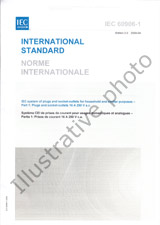We need your consent to use the individual data so that you can see information about your interests, among other things. Click "OK" to give your consent.

ISO 10303-223:2008
Industrial automation systems and integration — Product data representation and exchange — Part 223: Application protocol: Exchange of design and manufacturing product information for cast parts
Automatically translated name:
Industrial automation systems and integration -- Product data representation and exchange -- Part 223: Application protocol: Exchange of design and manufacturing product information for cast parts
STANDARD published on 20.3.2008
The information about the standard:
Designation standards: ISO 10303-223:2008
Publication date standards: 20.3.2008
SKU: NS-421815
The number of pages: 2340
Approximate weight : 7051 g (15.54 lbs)
Country: International technical standard
Category: Technical standards ISO
The category - similar standards:
Annotation of standard text ISO 10303-223:2008 :
Description / Abstract: ISO 10303-223:2008 specifies the use of the integrated resources necessary for the scope and information requirements for exchange, archiving and sharing of design and manufacturing product information for cast parts. The following are within the scope of ISO 10303-223:2008: the manufacturing of a cast part made by sand, die, and investment casting processes; parts that are to be manufactured by casting processes; design data for cast parts, including geometry, materials, tolerances, required physical and mechanical properties, required tests; casting features for defining shapes necessary for casting processes; manufacturing features for defining shapes necessary for machining processes; manufacturing features for defining shapes necessary for casting process; explicit representation of the 3D shape of casting features through bounded geometry representations; geometric and dimensional tolerances of the parts being manufactured; materials, and properties of the parts being manufactured; characterization of products used to make cast parts, including moulds, dies, equipment, materials, and consumable items; customer order administrative data to track receipt of an order for a cast part to the shop floor, but not including tracking of the order on the shop floor; approval data to authorize the manufacture of a cast part; requisition administrative data to identify requirements and track the status of materials and equipment needed to manufacture a cast part; work order data to track and identify the status of a cast part; tracking the state of raw stock for documenting the manufacturing history of a cast part; tracking a design exception notice of a cast part; process plans for parts that are made by sand, die, and investment casting processes: process data for part routing which includes manufacturing process and setup sequencing; process data for operation; work instructions for the tasks required to manufacture a cast part, which include: references to the resources required to perform the work; the sequences of the work instructions; relationships of the work to the part geometry; specifications for patterns and die assemblies; input to and output from casting process simulation software; data exchange between customer and foundry, within the foundry, and between foundry and supplier; use of data for foundry automation and shop floor control; use of data for archiving of design and manufacturing data for cast parts.
Similar standards:
28.2.1997
20.1.2005
30.4.2010
30.4.2010
30.4.2010
30.4.2010
We recommend:
Technical standards updating
Do you want to make sure you use only the valid technical standards?
We can offer you a solution which will provide you a monthly overview concerning the updating of standards which you use.
Would you like to know more? Look at this page.


 IEC 61506-ed.1.0..
IEC 61506-ed.1.0..
 Cookies
Cookies
